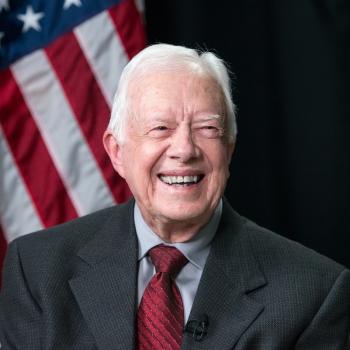In our Facebook world, it's not unusual to see relationships described as complicated. Such is the relationship Josh Stoneburner has with God. Our introduction to fourteen-year-old-protagonist, Joshua Stoneburner, in Jim Burklo's new novel, Souljourn, begins when Josh is hiking in the Arizona desert. He comes upon a cactus, in which appears an apparition of a young woman holding her hands out toward him. She is quickly transformed from a young woman to an old man (Lorenzo) who tells Josh to "follow her," before uttering two parting words: "I AM."
Returning home a bit shaken, Josh shares his experience with his Grandma Greta and Magdalena, a woman from his grandmother's church. Later, he tells the local Catholic priest, Father Crespi, about the vision. From then on his town refers to Josh's encounter as La Virgen de San Lorenzo, and Josh regrets his impulse to share as the town plagues him with questions, seeking a similar vision for themselves.
Meanwhile, Josh is motivated by his vision to start asking hard questions about God. The majority of the story concentrates on Josh's encounters with people of all faiths who, when asked, are happily willing to share their traditions with him—whether it's recommending a book, inviting him to a service, or suggesting he assist in a project that the group endorses.
The many philosophical and religious books he reads make Josh wonder "if there was any bottom to the open-pit mine of religion, or [if he] would keep digging spiritual ore out of it forever." The people he encounters—from a disturbed but honest war veteran to a young girl living with a Mormon family—help him see God in action. He attempts to unravel the mysteries of God by observing people's lives, and as we observe with him, we are introduced to various flavors of faith. In working out his own relationship with God, Josh is not afraid to point out inconsistencies in the stories we all tell ourselves in our own faith traditions. He wrestles with whether faith might simply be a way of being rather than a system of beliefs. But in the meantime, he listens to all the systems he can find and shares his findings with us.
Embedded in the story of Josh's search is also a clear message about immigration; we learn almost as much about the language of immigration and the southwest—words like cholla cactus, la migra, mojadas—as we do about the religious language of different faith traditions. Likewise, we are introduced to the environment—both social and political—surrounding the immigration issue. In a series of unfortunate events, Josh finds himself embroiled in a situation where a Native American friend is working as a lookout for drug dealers. His friend is hard up for cash and needs the money. On one of his adventures, he asks Josh to come along. Josh stays out of harm's way, but he learns some hard lessons about how people on the Mexican-American border feel about immigrants. He is exposed not only to hatred and prejudice, but also to the good-hearted efforts of many people of faith who are seeking to help the struggling immigrant population. He learns to listen to his own thoughts while watching people like Kate, the minister of an interfaith, ecumenical covenant group called the Federated Church, and Cal, the Quaker, use their "civil initiative" to actively live out the law of love that is written in their hearts, "so that we can live our way into a new law of the land."
This bildungsroman, reminiscent of Piscine Patel's search in Life of Pi or the under-the-radar movie Henry Poole Is Here, is an invitation to accompany Josh through his adolescence, a time when many young boys are spending most of their time playing video games. He is an unusual high-schooler, one who has a keen interest in the why's and how's instead of the what's; consequently, we experience the way his teenage mind processes the world. Sometimes it's earthy—his sexual drives are unmistakable—and sometimes naïve, but through it all, we get a solid look into his world, and by the end we care about the way the world is treating him. Fortunately, the people he meets cheer him on toward his goal to discover what faith means to him. Sometimes the various representatives of his faith collide a bit, but in the end we may conclude that a little tension is a good thing when it comes to ironing out how faith works. And, as Josh's Grandma Greta so aptly states about matters of faith, "it's a mystery."
Those looking for answers will not find them in this novel. But the story, like the apparition that Josh sees in the desert, extends a hand, reaching out to anyone who will take it and leading them through the complicated and circuitous journey of doubt and belief.
Stacy Morgan's new book, 52 Ways to Worship: A Year of Exploring Religious Traditions, recounts her week-by-week adventures in communities of worship—from various Christian denominations to Jainist, Sikh, Buddhist, Hindu, Scientology, and more.
12/2/2022 9:02:28 PM




